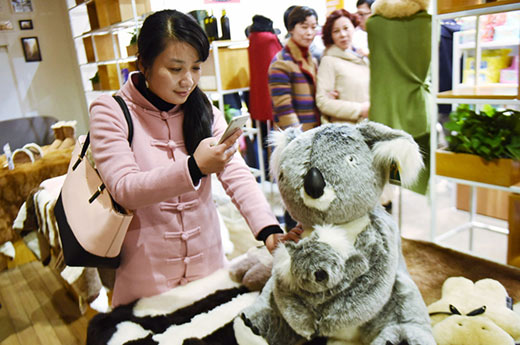當前位置: Language Tips> 雙語新聞
Women driving growth of online-to-offline business in China
分享到

Females have become the driving force behind China's booming online-to-offline shopping sector, despite their minority position in the country's overall Internet-using population.
女性群體成為中國“線上到線下”(online-to-offline,簡稱O2O)購物業日益繁榮的推動力,盡管女性只占中國網民總量的少數。
According to a new report from group-buying e-commerce website Baidu Nuomi, women now account for 46 percent of the country's Internet users, but they generate 62 percent of O2O revenues.
根據團購電商網站百度糯米發布的報告,女性用戶現占中國網民總量的46%,卻為中國O2O產業貢獻了62%的收入。
Baidu Nuomi claims it now accounts for a fifth of daily O2O sales-a rapidly growing market that enables online customers to pay online for bricks-and-mortar services, such as movie tickets and restaurant bookings.
百度糯米宣布本網站占日常O2O銷售份額的五分之一。O2O市場現正迅速發展壯大,通過O2O模式,消費者可在線上訂購傳統的實體服務,例如購買電影票和預訂餐廳座位。
Tang Lihua, a director at Baidu Nuomi, said the results show that attracting, then retaining, female shoppers has become critical for any O2O platform.
百度糯米總監湯利華表示,從統計結果可以看出,吸引并留住女性消費者對O2O平臺的發展至關重要。
"We plan to provide more baby-related and beauty-related services and products, for instance, in order to further grow our business, as we think that's likely to be strong selling-point for women," she said.
湯利華說:“為了促進企業發展,我們計劃提供更多的育嬰、美容產品和服務,因為我們認為這對女性群體來說是一個重要賣點。”
The study showed that since the start of 2015, female O2O spending has far-outstripped that by males, and the gap is growing, particularly during the country's flagship shopping events such as Qixi, Chinese Valentines Day.
研究結果還顯示,自2015年起,女性的O2O消費額已大大超過男性,并且差距還在進一步擴大。這得益于中國幾大購物節的刺激作用,例如七夕節,也就是中國情人節的促銷活動。
As well as the beauty-related sector, women outspent men in other lucrative areas, too, including gyms and leisure, and hotels, said the report.
報告還稱,除了美容消費外,女性在其他營利領域的消費也超過了男性,包括健身、休閑和酒店消費。

Gao Shuang, an analyst with China Internet Network Information Center, said the main reason is simple: Women are more decisive when it comes to shopping.
中國互聯網絡信息中心分析師高爽認為原因顯而易見:女性在購物時更為果斷。
"They are not only buying for themselves, they are also shopping for their parents, their husbands and children," she said, adding their pickiness, too, is also driving up improvements in services and product innovation.
高爽說:“女性不僅給自己買東西,還給父母、丈夫和孩子買東西。”并且女性在購物時較為挑剔,這也促進了服務的改進和產品的創新。
According to the center's statistics, the number of female online shoppers grew to 180 million by the end of 2015, more than double the number in 2010.
中國互聯網絡信息中心的數據顯示,截至2015年底,中國女性網購者的數量已增長到1.8億,是2010年的兩倍有余。
They also showed female online shoppers spend 4.17 hours a day surfing the Internet, against a daily average of 3.74 hours by all Internet users in China.
數據還顯示,女性網購者平均每天花4.17小時上網,而中國全體網民平均每天的上網時間為3.74小時。
Restaurants, travel spending and movie trips were the top three O2O sellers for women.
女性在O2O平臺上消費最高的三大領域分別是餐飲、旅游和電影。
Zhou Shu, a senior executive at Yuxiang Renjia, a restaurant chain specialized in Sichuan dishes, said it had certainly noticed that women have the stronger say when it comes to deciding where to eat.
川菜餐飲連鎖“渝鄉人家”高級主管周澍稱,女性在點菜時也更有話語權。
"And they are more willing to try new services and new products," she said.
周澍說:“女性更愿意嘗試新服務和新產品。”
"Most importantly, though, they are happy to communicate and exchange their feedback after eating at a new restaurant, which makes them more influential in the O2O market."
“最重要的是,女性在體驗過一家新餐館后也樂于反饋和交流意見,這使得她們在O2O市場中更具影響力。”
英文來源:中國日報
譯者:牛歡
審校&編輯:丹妮
上一篇 : 分享狂愛分享的原因在大腦
下一篇 : 你會單身到老嗎?
分享到
關注和訂閱


電話:8610-84883645
傳真:8610-84883500
Email: languagetips@chinadaily.com.cn